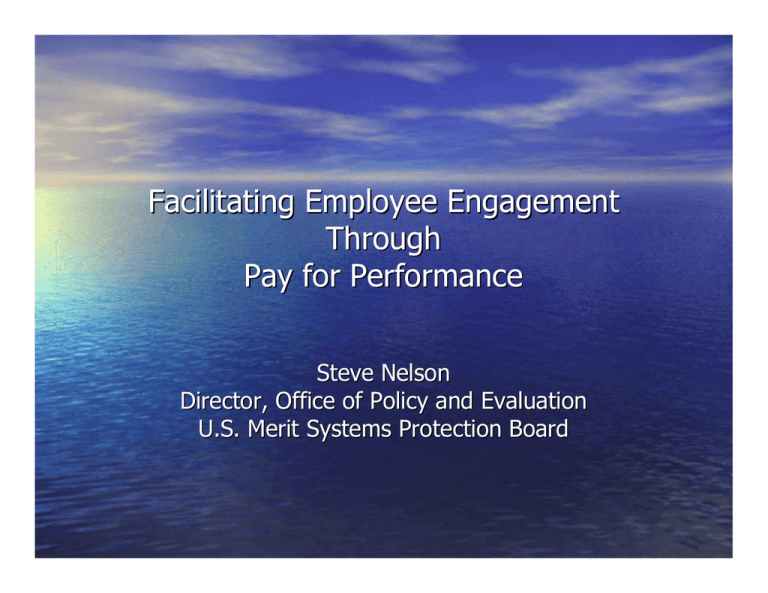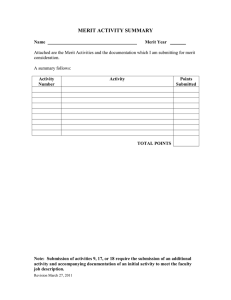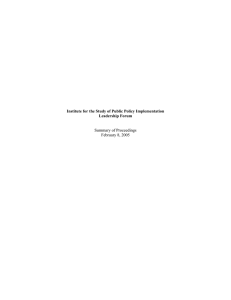Facilitating Employee Engagement Through Pay for Performance Steve Nelson
advertisement

Facilitating Employee Engagement Through Pay for Performance Steve Nelson Director, Office of Policy and Evaluation U.S. Merit Systems Protection Board Pay for Performance is a better way to pay • Meets the merit principle of equal pay for work of equal value and reward excellence. • May be fairer than the GS because it recognizes contributions, not tenure. • Helps recruitment and retention of HiPos. • Shows little evidence of moving organizational performance by itself. Impact of Pay on Employees • Top pay increases Retention of “superstars” • Average pay Impact on “B” employees • No pay increases Turnover of underperformers increases Reasons to leave Government 7 Desire for different work 8 Lack of recognition Increase opportunities for advancement 18 Desire to earn more money 20 Better use of skills and abilities 22 0 5 10 Source: MSPB, Merit Principles Survey 2000 15 20 25 Reasons to stay in Government Current working schedule 76 Your pay compared to outside Gov't 77 Current job duties/responsibilities 82 Job security 86 Federal benefit programs 91 65 70 75 Source: MSPB, Merit Principles Survey 2000 80 85 90 95 What motivates employees? Percent including factor among their top three 90 80 80 70 60 54 50 40 27 30 23 21 20 10 0 Personal pride Desire to or satisfaction make a in my work contribution Monetary award Public duty Source: MSPB, Merit Principles Survey 2000 Desire to help work unit meet goals Performance • Employee performance • Organizational performance • Whole is greater than the sum of the parts Corporate Leadership Council research • Pay for performance helps recruitment and retention of high performers • Pay for performance does not necessarily improve organizational performance • Employee engagement is the key to improving organizational performance Source: CLC 2004 Employee Engagement Survey Employee Engagement The extent to which employees commit to something or someone in their organization and how hard they work and how long they stay as a result of that commitment. Components of Engagement Rational Commitment: Emotional commitment: Are the employee’s financial, developmental or professional needs being met? Does the employee value, enjoy and believe in their job, manager, team, or organization? Impact on Outcomes Engagement – Rational Attraction/Retention – Emotional Discretionary Effort Relationship between Pay for Performance and Employee Engagement • Allow pay setting flexibility to attract and retain high performers. • Emphasize new supervisory behaviors facilitating emotional commitment. • Supervisory behaviors affect employee engagement. Supervisory Behaviors Maximizing Discretionary Effort • Clearly articulates organizational goals • Sets realistic performance expectations • Adapts to changing circumstances • Helps find solutions to problems • Demonstrates honesty and integrity • Possesses job skills • People in the right roles at the right time • Commitment to diversity “To what extent do you think your supervisor will exercise the following authorities in a fair and effective manner?” Setting individual employees' pay within broad pay bands Taking adverse actions such as suspensions and removals Selecting people for vacancies or promotions based on their qualifications Source: MSPB, Merit Principles Survey 1996 36 37 59 Pay for Performance is a better way to pay • Meets the merit principle of equal pay for work of equal value and reward excellence. • May be fairer than the GS because it recognizes contributions, not tenure. • Helps recruitment and retention of HiPos. • Shows little evidence of moving organizational performance by itself. For more information on MSPB studies http://www.mspb.gov Steve.Nelson@mspb.gov


